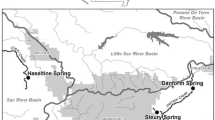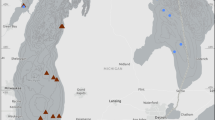Abstract
Biotic calcification is rarely considered in freshwater C budgets, despite calculations suggesting that calcifying animals can alter inorganic C cycling. Most studies that have quantified biocalcification in aquatic ecosystems have not directly linked CO2 fluxes from biocalcification with whole-ecosystem rates of inorganic C cycling. The freshwater snail, Melanoides tuberculata, has achieved a high abundance and 37.4 g biomass m−2 after invading Kelly Warm Springs in Grand Teton National Park. This high biomass suggests that introduced populations of Melanoides may alter ecosystem processes. We measured Melanoides growth rates and biomass to calculate the production of biomass, shell mass, and CO2. We compared Melanoides biomass and inorganic C production with ecosystem C pools and fluxes, as well as with published rates of CO2 production by other calcifying organisms. Melanoides calcification in Kelly Warm Springs produced 12.1 mmol CO2 m−2 day−1 during summer months. We measured high rates of gross primary productivity and respiration in Kelly Warm Springs (−378 and 533 mmol CO2 m−2 day−1, respectively); CO2 produced from biocalcification increased net CO2 production in Kelly Warm Springs from 155 to 167 mmol CO2 m−2 day−1. This rate of CO2 production via biocalcification is within the published range of calcification by animals. But these CO2 fluxes are small when compared to ecosystem C fluxes from stream metabolism. The influence of animals is relative to ecosystem processes, and should always be compared with ecosystem fluxes to quantify the importance of a specific animal in its environment.




Similar content being viewed by others
References
Benke AC (1984) Secondary production of aquatic insects. In: Resh VH, Rosenberg DM (eds) Ecology of aquatic insects. Praeger, New York, pp 289–322
Benke AC, Huryn AD, Smock LA, Wallace JB (1999) Length-mass relationships for freshwater macroinvertebrates in North America with particular reference to the southeastern United States. J North Am Benthol Soc 18:308–343
Berry AJ, Kadri ABH (1974) Reproduction in the Malayan freshwater cerithiacean gastropod Melanoides tuberculata. J Zool 172:369–381
Cai W-J, Wang Y (1998) The chemistry, fluxes, and source of carbon dioxide in the estuarine waters of the Satilla and Altamaha Rivers, Georgia. Limnol Oceanogr 43:657–668
Caraco NF, Cole JJ, Raymond PA, Strayer DL, Pace ML, Findlay SEG, Fischer DT (1997) Zebra mussel invasion in a large, turbid river: phytoplankton response to increased grazing. Ecology 78:588–602
Caraco NF, Cole JJ, Findlay SEG, Fischer DT, Lampman GG, Pace ML, Strayer DL (2000) Dissolved oxygen declines in the Hudson River associated with the invasion of the zebra mussel (Dreissena polymorpha). Environ Sci Technol 34:1204–1210
Chauvaud L, Thompson JK, Cloern JE, Thouzeau G (2003) Clams as CO2 generators: the Potamocorbula amurensis example in San Francisco Bay. Limnol Oceanogr 48:2086–2092
Cole JJ, Caraco NF (1998) Atmospheric exchange of carbon dioxide in a low wind oligotrophic lake measured by the addition of SF6. Limnol Oceanogr 43:647–656
Cole JJ, Caraco NF, Kling GW, Kratz TK (1994) Carbon dioxide supersaturation in the surface waters of lakes. Science 265:1568–1570
Cole JJ, Pace ML, Carpenter SR, Kitchell JF (2000) Persistence of net heterotrophy in lakes during nutrient additions and food web manipulations. Limnol Oceanogr 45:1718–1730
Cole JJ, Prairie YT, Caraco NF, McDowell WH, Tranvik LJ, Striegl RG, Duarte CM, Kortelainen P, Downing JA, Middleburg JJ, Melack J (2007) Plumbing the global carbon cycle: integrating inland waters into the terrestrial carbon budget. Ecosystems 10:171–184
De’ath G, Lough JM, Fabricius KE (2009) Declining coral calcification on the Great Barrier Reef. Science 323:116–119
Duarte CM, Prairie YT (2005) Prevalence of heterotrophy and atmospheric CO2 emissions from aquatic ecosystems. Ecosystems 8:862–870
Dudgeon D (1986) The life cycle, population dynamics and productivity of Melanoides tuberculata (Müller, 1774) (Gastropoda: Prosobranchia: Thiaridae) in Hong Kong. J Zool 208:37–53
Duggan IC (2002) First record of a wild population of the tropical snail Melanoides tuberculata in New Zealand natural waters. NZ J Mar Freshwater Res 36:825–829
Fabry VF (1990) Shell growth rates of pteropod and heteropod molluscs and aragonite production in the open ocean: implications for the marine carbonate system. J Mar Res 48:209–222
Facon B, Pointer J-P, Glaubrecht M, Poix C, Jarne P, David P (2003) A molecular phylogeography approach to biological invasions of the New World by parthenogenetic Thiarid snails. Mol Ecol 12:3027–3039
Facon B, Jarne P, Pointier JP, David P (2005) Hybridization and invasiveness in the freshwater snail Melanoides tuberculata: hybrid vigor is more important than increase in genetic variance. J Evol Biol 18:524–535
Facon B, Genton BJ, Shykoff J, Jarne P, Estoup A, David P (2006) A general eco-evolutionary framework for understanding bioinvasions. Trends Ecol Evol 21:130–135
Frankignoulle M, Canon C, Gattuso J-P (1994) Marine calcification as a source of carbon dioxide: positive feedback of increasing atmospheric CO2. Limnol Oceanogr 39:458–462
Golléty C, Gentil F, Davoult D (2008) Secondary production, calcification and CO2 fluxes in the cirripedes Chthamalus montagui and Elminius modestus. Oecologia 155:133–142
Hall RO, Tank JL (2005) Correcting whole-stream estimates of metabolism for groundwater input. Limnol Oceanogr Methods 3:222–229
Hall RO, Tank JL, Dybdahl MF (2003) Exotic snails dominate nitrogen and carbon cycling in a highly productive stream. Front Ecol Environ 1:407–411
Hall RO, Dybdahl MF, VanderLoop MC (2006) Extremely high secondary production of introduced snails in rivers. Ecol Appl 16:1121–1131
Hall RO, Thomas S, Gaiser EE (2007) Measuring primary production and respiration in freshwater ecosystems. In: Fahey TJ, Knapp AK (eds) Principles and standards for measuring primary production. Oxford University Press, Oxford, pp 175–203
Huryn AD, Benke AC, Ward GM (1995) Direct and indirect effects of geology on the distribution, biomass, and production of the freshwater snail Elimia. J North Am Benthol Soc 14:519–534
Jones JB, Mulholland PJ (1998) Influence of drainage basin topography and elevation on carbon dioxide and methane supersaturation of stream water. Biogeochemistry 40:57–72
Kiibus M, Kautsky N (1996) Respiration, nutrient excretion and filtration rate of tropical freshwater mussels and their contribution to production and energy flow in Lake Kariba, Zimbabwe. Hydrobiologia 331:25–32
Langmuir D (1997) Aqueous environmental chemistry. Prentice Hall, Upper Saddle River
Martin S, Thouzeau G, Chauvaud L, Jean F, Guérin L, Clavier J (2006) Respiration, calcification, and excretion of the invasive slipper limpet, Crepidula fornicata L.: implications for carbon, carbonate, and nitrogen fluxes in affected areas. Limnol Oceanogr 51:1996–2007
Migné A, Davoult D, Gattuso J-P (1998) Calcium carbonate production of a dense population of the brittle star Ophiothrix fragilis (Echinodermata: Ophiuroidea): role in the carbon cycle of a temperate coastal ecosystem. Mar Ecol Prog Ser 173:305–308
Millero FJ (1979) The thermodynamics of the carbonate system in seawater. Geochim Cosmochim Acta 43:1651–1661
Mulholland PJ, Fellows CS, Tank JL, Grimm NB, Webster JR, Hamilton SK, Martí E, Ashkenas L, Bowden WB, Dodds WK, McDowell WH, Paul MJ, Peterson BJ (2001) Inter-biome comparison of factors controlling stream metabolism. Freshwater Biol 46:1503–1517
Odum HT (1956) Primary production in flowing waters. Limnol Oceanogr 1:102–117
Pointier JP, Delay B, Toffart JL, Lefevre M, Romero-Alvarez R (1992) Life history traits of three morphs of Melanoides tuberculata (Gastropoda: Thiaridae), an invading snail in the French West Indies. J Mollusc Stud 58:415–423
Pointier JP, Théron A, Borel G (1993) Ecology of the introduced snail Melanoides tuberculata (Gastropoda: Thiaridae) in relation to Biomphalaria glabrata in the marshy forest zone of Guadeloupe, French West Indies. J Mollusc Stud 59:421–428
R Development Core Team (2009) R: a language and environment for statistical computing. Vienna
Rader RB, Belk MC, Keleher MJ (2003) The introduction of an invasive snail (Melanoides tuberculata) to spring ecosystems of the Bonneville Basin, Utah. J Freshwater Ecol 18:647–657
Raine RCT (1983) The effect of nitrogen supply on the photosynthetic quotient of natural phytoplankton assemblages. Bot Mar 26:417–423
Richey JE, Melack JM, Aufdenkampe AK, Ballester MV, Hess LL (2002) Outgassing from Amazonian rivers and wetlands as a large tropical source of atmospheric CO2. Nature 416:617–620
Roberts BJ, Mulholland PJ, Hill WR (2007) Multiple scales of temporal variability in ecosystem metabolism rates: results from 2 years of continuous monitoring in a forested headwater stream. Ecosystems 10:588–606
Robinson DG (1999) Alien invasions: the effects of the global economy on non-marine gastropod introductions into the United States. Malacologia 41:413–438
SAS Institute (2002–2003) SAS/STAT User’s Guide, Release 9.1.3. SAS Institute, Cary
Schindler DE, Carpenter SR, Cole JJ, Kitchell JF, Pace ML (1997) Influence of food web structure on carbon exchange between lakes and the atmosphere. Science 277:248–251
Silverman J, Lazar B, Cao L, Caldeira K, Erez J (2009) Coral reefs may start dissolving when atmospheric CO2 doubles. Geophys Res Lett 36:L05606. doi:10.1029/2008GL036282
Smith SV (1972) Production of calcium carbonate on the mainland shelf of southern California. Limnol Oceanogr 17:28–41
Smith AM, Nelson CS (1994) Calcification rates of rapidly colonizing bryozoans in Hauraki Gulf, northern New Zealand. NZ J Mar Freshwater Res 28:227–234
Strayer DL, Malcom HM (2007) Shell decay rates of native and alien freshwater bivalves and implications for habitat engineering. Freshwater Biol 52:1611–1617
Strayer DL, Caraco NF, Cole JJ, Findlay S, Pace ML (1999) Transformation of freshwater ecosystems by bivalves: a case study of zebra mussels in the Hudson River. Bioscience 49:19–27
Subba Rao NV, Mitra SC (1982) Bioecology of two melaniid snails (Mollusca: Gastropoda) in ponds near Calcutta. J Zool Soc (India) 1&2:21–32
Taylor BW, Flecker AS, Hall RO (2006) Loss of a harvested fish species disrupts carbon flow in a diverse tropical river. Science 313:833–836
United States Geological Survey (2005) Nonindigenous aquatic species database, Gainesville. http://nas.er.usgs.gov. Accessed Mar 2007
Wanninkhof R (1992) Relationship between wind speed and gas exchange over the ocean. J Geophys Res 97:7373–7382
Wanninkhof R, Mulholland PJ, Elwood JW (1990) Gas exchange rates for a first order stream determined with deliberate and natural tracers. Water Resour Res 26:1621–1630
Ware JR, Smith SV, Reaka-Kudla ML (1991) Coral reefs: sources or sinks of atmospheric CO2? Coral Reefs 11:127–130
Wetzel RG (2001) Limnology, 3rd edn. Academic Press, San Diego
Wetzel RG, Likens GE (2000) Limnological analyses, 3rd edn. Springer, New York
Williams PB, del Giorgio PA (2005) Respiration in aquatic ecosystems: history and background. In: del Giorgio PA, Williams PB (eds) Respiration in aquatic ecosystems. Oxford University Press, Oxford, pp 1–17
Wilson RW, Millero FJ, Taylor JR, Walsh PJ, Christiansen V, Jennings S, Grosell M (2009) Contribution of fish to the marine inorganic carbon cycle. Science 323:344–359
Young RG, Matthaei CD, Townsend CR (2008) Organic matter breakdown and ecosystem metabolism: functional indicators for assessing river ecosystem health. J North Am Benthol Soc 27:605–625
Acknowledgments
We thank E. Pendall, A. Krist, D. Strayer, E. Hansen, A. Ulseth, L. Kunza and two anonymous reviewers for helpful comments on earlier drafts of our manuscript. S. O’Ney and H. Harlow provided logistical support. R. Crosby, J. Theurer, N. Swoboda-Colberg, and T. Lehnertz assisted with field and lab work. Discussions with J. Meyer also contributed to this research. This project was funded by a University of Wyoming–National Park Service research grant. Research was also supported by a Plummer Scholarship (School of Environment and Natural Resources, University of Wyoming), a Dennis Jesperson Memorial Scholarship (Wyoming Wildlife Fund), and a Colorado Lake and Reservoir Management Association Scholarship. This manuscript is a contribution to the University of Wyoming–National Park Service Research Station.
Author information
Authors and Affiliations
Corresponding author
Additional information
Communicated by Barbara Downes.
An erratum to this article can be found at http://dx.doi.org/10.1007/s00442-010-1574-8
Rights and permissions
About this article
Cite this article
Hotchkiss, E.R., Hall, R.O. Linking calcification by exotic snails to stream inorganic carbon cycling. Oecologia 163, 235–244 (2010). https://doi.org/10.1007/s00442-009-1536-1
Received:
Accepted:
Published:
Issue Date:
DOI: https://doi.org/10.1007/s00442-009-1536-1




